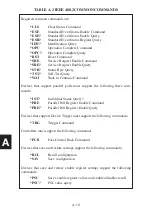
A-15
A2
A2
SERIAL DATA COMMUNICATION BACKGROUND
A2.1 Introduction to Serial Communication
Serial data communication is the most common means of transmitting data
from one point to another. In serial communication systems, the data word
or character is sent bit by bit over some kind of transmission path. The
receiving device recognizes each bit as they are received and reassembles
them back into the original data word. Serial data communication systems
are characterized by four primary factors:
1.
Data speed or baud rate
2.
Data format
3.
Transmission medium
4.
Clocking method
Serial data speed is referred to as Baud Rate. A baud is defined as a sig-
naling bit, which includes data bits as well as start/stop framing, parity or
any other bits that make up the data format. Typical computer baud rates
and their uses are:
110 - for old mechanical teletypes
300, 1200 - for low speed devices an older modems
9600 to 38400 baud for high speed devices and newer
modems
Data format refers to the method or pattern the transmitter uses to send the
data word or character as a series of bits so that the receiver will know how
to recognize the pattern and reassemble the bits back into the original data
word. The most common method and the one used in the 2303, is called
asynchronous transmission because each character is sent one at a time with
an undetermined amount of time between characters. Each asynchronous
character has a low going start bit, a number of data bits, an optional parity
bit and 1 or 2 high stop bits. The transmitter automatically extends the stop
bit when it has no more characters to transmit. The receiver uses the start
bit to resynchronize its clock with the data at the start of each character as
shown in Figure A-7.
Summary of Contents for 4809A
Page 5: ...ii This page left intentionally blank...
Page 51: ...2 30 2 This page left intentionally blank...
Page 89: ...4 8 4 This page intentionally left blank...
Page 99: ...5 10 5 This page left intentionally blank...
Page 125: ...A 26 A3 This page intentionally left blank...
Page 131: ...I Index 6 This page left intentionally blank...
















































